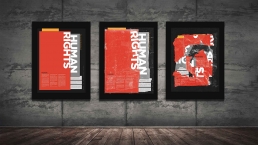BRIEF
Objective:
With this project, our goal was to design a 3-poster series where we would visually apply a given verb to each poster in order to creatively explore new, unique methods of design and tell a story.
Process:
First, we were first instructed to select one of the following typefaces—Akzidenz Grotesk, Gotham, Scala, or Frutiger—and with it, create a 3-color poster that demonstrates strong typographic composition with special attention to hierarchy, scale, grid, and alignment while striving to create asymmetric, yet balanced designs. Content-wise, the poster had to be solely typographic, comprised of the Preamble of The Universal Declaration of Human Rights by The United Nations.
After experimenting, receiving feedback, and finalizing our first poster design, we were assigned a verb at random in which we were to visually demonstrate its definition/concept by applying it to this first finalized poster. I was given “tear”, and so with my series I wanted to not only demonstrate a physical definitions of the word, such as “to rip a piece of paper”, but a conceptual one as well, “to divide or disrupt something by the pull of contrary forces”.
POSTER SERIES
Story:
The posters represent a metaphoric timeline, documenting how human rights are changing with the times. In the first (left), the poster is untouched, representing that from its forging, the UDHR appeared to be seamless and apply to everybody universally.
In the second (middle), small tears begin to appear, but in general the layout of the document has been held in place by using pieces of tape. Symbolically, this represents how although flaws in society that weren’t originally considered in The UDHR began to become apparent over time, society hadn’t yet taken them too seriously and would rather keep things structured the way they were.
With the third (right), tears have now gone all the way through the poster with pieces being destroyed, dispersed, and illegible. This is meant to represent how today societal issues are more apparent than ever—where whether it be political, racial, gender, or social class-based inequality—there’s an increasingly clear imbalance between people, forcing opposing sides to divide more than ever. With all this, it’s also becoming increasingly apparent that many of these declared human rights aren’t being abided by nor truly universal. However, this deformed poster still is the UDHR at its core, most clearly evidenced with the beginning of the preamble being the most legible part of the poster. With the beginning of the preamble being the most legible, this depicts how despite these inequalities, the document’s intentions have been pure since the beginning. Now, it’s time to embrace these flaws with human rights, and begin, metaphorically, putting this document and society back together before they’re “torn” even more.



